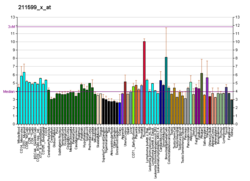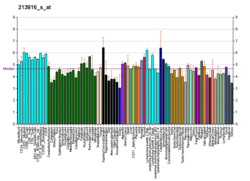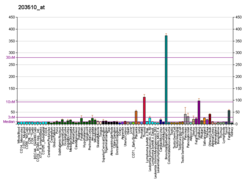Hepatocyte growth factor receptor (HGF receptor)[5][6] is a protein that in humans is encoded by the MET gene. The protein possesses tyrosine kinase activity.[7] The primary single chain precursor protein is post-translationally cleaved to produce the alpha and beta subunits, which are disulfide linked to form the mature receptor.
HGF receptor is a single pass tyrosine kinase receptor essential for embryonic development, organogenesis and wound healing. Hepatocyte growth factor/Scatter Factor (HGF/SF) and its splicing isoform (NK1, NK2) are the only known ligands of the HGF receptor. MET is normally expressed by cells of epithelial origin, while expression of HGF/SF is restricted to cells of mesenchymal origin. When HGF/SF binds its cognate receptor MET it induces its dimerization through a not yet completely understood mechanism leading to its activation.
Sometimes MET is misunderstood as of an abbreviation of Mesenchymal-Epithelial Transition. It is incorrect. The three letters of MET come from N-methyl-N'-nitro-N-nitrosoguanidine (MNNG). [8]
Abnormal MET activation in cancer correlates with poor prognosis, where aberrantly active MET triggers tumor growth, formation of new blood vessels (angiogenesis) that supply the tumor with nutrients, and cancer spread to other organs (metastasis). MET is deregulated in many types of human malignancies, including cancers of kidney, liver, stomach, breast, and brain. Normally, only stem cells and progenitor cells express MET, which allows these cells to grow invasively in order to generate new tissues in an embryo or regenerate damaged tissues in an adult. However, cancer stem cells are thought to hijack the ability of normal stem cells to express MET, and thus become the cause of cancer persistence and spread to other sites in the body. Both the overexpression of Met/HGFR, as well as its autocrine activation by co-expression of its hepatocyte growth factor ligand, have been implicated in oncogenesis.[9][10]
Various mutations in the MET gene are associated with papillary renal carcinoma.[11]
- ^ a b c GRCh38: Ensembl release 89: ENSG00000105976 – Ensembl, May 2017
- ^ a b c GRCm38: Ensembl release 89: ENSMUSG00000009376 – Ensembl, May 2017
- ^ "Human PubMed Reference:". National Center for Biotechnology Information, U.S. National Library of Medicine.
- ^ "Mouse PubMed Reference:". National Center for Biotechnology Information, U.S. National Library of Medicine.
- ^ Bottaro DP, Rubin JS, Faletto DL, Chan AM, Kmiecik TE, Vande Woude GF, et al. (February 1991). "Identification of the hepatocyte growth factor receptor as the c-met proto-oncogene product". Science. 251 (4995): 802–4. Bibcode:1991Sci...251..802B. doi:10.1126/science.1846706. PMID 1846706.
- ^ Galland F, Stefanova M, Lafage M, Birnbaum D (1992). "Localization of the 5' end of the MCF2 oncogene to human chromosome 15q15----q23". Cytogenet. Cell Genet. 60 (2): 114–6. doi:10.1159/000133316. PMID 1611909.
- ^ Cooper CS (January 1992). "The met oncogene: from detection by transfection to transmembrane receptor for hepatocyte growth factor". Oncogene. 7 (1): 3–7. PMID 1531516.
- ^ Cooper CS, Park M, Blair DG, Tainsky MA, Huebner K, Croce CM, et al. (6 September 1984). "Molecular cloning of a new transforming gene from a chemically transformed human cell line". Nature. 311 (5981): 29–33. doi:10.1038/311029a0. PMID 6590967.
- ^ Johnson M, Koukoulis G, Kochhar K, Kubo C, Nakamura T, Iyer A (September 1995). "Selective tumorigenesis in non-parenchymal liver epithelial cell lines by hepatocyte growth factor transfection". Cancer Letters. 96 (1): 37–48. doi:10.1016/0304-3835(95)03915-j. PMID 7553606.
- ^ Kochhar KS, Johnson ME, Volpert O, Iyer AP (1995). "Evidence for autocrine basis of transformation in NIH-3T3 cells transfected with met/HGF receptor gene". Growth Factors. 12 (4): 303–13. doi:10.3109/08977199509028968. PMID 8930021.
- ^ "Entrez Gene: MET met proto-oncogene (hepatocyte growth factor receptor)".






